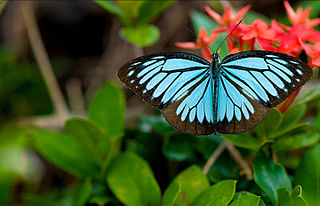
Apamea crenata, known as the clouded-bordered brindle, is a moth in the family Noctuidae. It is distributed throughout the Palearctic realm. In the North it crosses the Arctic Circle, in the Mediterranean it is found only in cool locations and mountains avoiding very hot areas. In the Alps, it rises to an altitude of about 2000 metres.

Graphium antiphates, the five-bar swordtail, is a species of papilionid butterfly found in south and southeast Asia. The species was first described by Pieter Cramer in 1775.

Pareronia valeria, the common wanderer or Malayan wanderer, is a medium-sized butterfly of the family Pieridae, that is, the yellows and whites, and is found in India and Southeast Asia. The butterfly found in India is sometimes considered as a separate species, Pareronia hippia.

Jamides bochus, the dark cerulean, is a small butterfly found in Indomalayan realm that belongs to the lycaenids or blues family. The species was first described by Caspar Stoll in 1782.

Hypolimnas misippus, the Danaid eggfly, mimic, or diadem, is a widespread species of nymphalid butterfly. It is well known for polymorphism and mimicry. Males are blackish with distinctive white spots that are fringed in blue. Females are in multiple forms that include male-like forms while others closely resemble the toxic butterflies Danaus chrysippus and Danaus plexippus.

Curetis bulis, the bright sunbeam, is a species of butterfly belonging to the lycaenid family. It is found in Asia.
Alpherakya sarta is a Palearctic species of lycaenid butterfly found in Afghanistan, Pakistan, Ghissar, Alai, Tian-Shan, Tarbagatai, Saur, South Altai and North India.

The Indian fritillary is a species of butterfly of the nymphalid or brush-footed family. It is usually found from south and southeast Asia to Australia.

Enispe cycnus, the blue caliph, is a species of nymphalid butterfly found in Southeast Asia.

Catochrysops strabo, the forget-me-not, is a small butterfly found in Asia that belongs to the lycaenids or blues family. The species was first described by Johan Christian Fabricius in 1793. It is found in Sri Lanka, India, from Sikkim to Indochina and in Sundaland, Sulawesi and the Philippines.

Agdistopis halieutica is a moth in the Macropiratidae family. It is found from Australia and New Guinea to Fiji.
Endobrachys is a monotypic moth genus in the family Megalopygidae. It contains only one species, Endobrachys revocans, which is found in Peru, French Guiana and Brazil.

Pareronia hippia, the common wanderer or Indian wanderer, is a medium-sized butterfly of the family Pieridae, that is, the yellows and whites. It is found in India. Some authors consider this as a subspecies of Pareronia valeria.
Stenorista fortunata is a moth in the family Crambidae. It was described by Schaus in 1912. It is found in Costa Rica.
Syllepte leucographalis is a moth in the family Crambidae. It was described by George Hampson in 1912. It is found in Indonesia (Bali).
Syllepte methyalinalis is a moth in the family Crambidae. It was described by George Hampson in 1912. It is found in Guyana.
Tylostega tylostegalis is a moth in the family Crambidae. It was described by George Hampson in 1900. It is found in the Russian Far East and western China.
Ulopeza sterictodes is a species of moth in the family Crambidae. It was described by George Hampson in 1912. It is found in Papua New Guinea.
Antaeotricha mesosaris is a moth of the family Depressariidae. It is found in French Guiana.
Chlamydastis trastices is a moth in the family Depressariidae. It was described by August Busck in 1911. It is found in French Guiana and Guyana.










